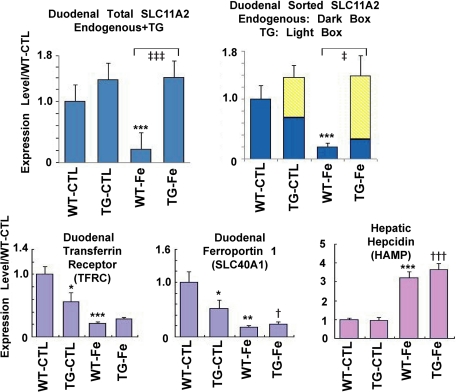Figure 3.
Iron metabolism in the SLC11A2 transgenic mice. Expression of iron metabolism genes before and after an iron-rich diet (24 hours after start). The overall mRNA expression of SLC11A2 was constantly higher in the transgenic mice, which was especially prominent under an iron-rich diet. An iron-rich diet suppressed the duodenal expression of the transferrin receptor and ferroportin-1 genes, but increased the hepatic expression of hepcidin (N = 4 to 5, means ± SEM; *P < 0.05; **P < 0.01; ***P < 0.001 vs. WT-CTL; †P < 0.05; †††P < 0.001 vs. TG-CTL; ‡P < 0.01; ‡‡‡P < 0.001 vs. WT-Fe). One-way analysis of variance test for comparison among multiple groups detected statistical significance in all of the analyses of five genes (Total SLC11A2, P = 0.0034; Endogenous SLC11A2, P = 0.0012; TFRC, P = 0.0007; SLC40A1, P = 0.0020; and HAMP, P = 0.00002). CTL, control basal diet; WT-Fe, wild-type mice under an iron-rich diet; TG-Fe, transgenic mice under an iron-rich diet.

